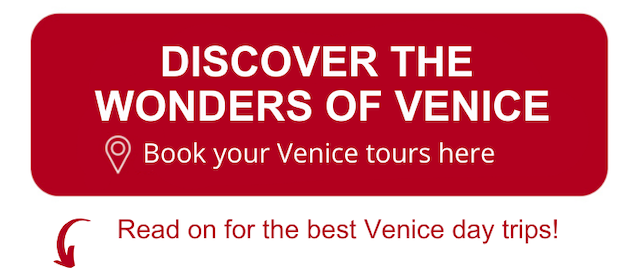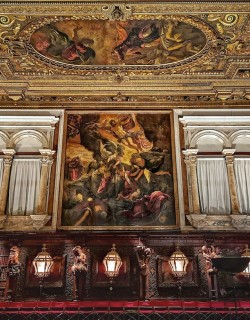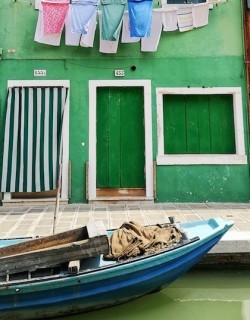Venice is a destination so rich in art, history, and atmosphere that you might wonder why anyone would ever want to leave. And indeed, you could easily occupy yourself for an entire vacation without tiring of scudding along serene canals and exploring truly breathtaking monuments. But if this isn’t your first visit - or if you’re the type of traveler that’s always looking to expand your horizons, then you’ll be happy to hear that Venice makes for an excellent base for day trip excursions into the wider Veneto region.
Thanks to excellent public transport connections by rail, road and water, it’s a cinch to reach some of northern Italy’s most enchanting destinations, from glittering cities of art like Padua and Verona to atmospheric island hideouts like Burano and Torcello - all while sampling some of the best regional cuisine and wine in Italy along the way. Ready to get started? Here are seven of the best day trips to take from Venice!
Verona

Although it’s probably most famous as the dramatic stage for Shakespeare’s great tragedy of forbidden love, there’s much more to Fair Verona than Romeo and Juliet. This spectacular city boasts a history extending all the way back to antiquity, when it was one of the most important centers of the Roman Empire in northern Italy - the grand Arena amphitheater (site of dazzling open-air operas every summer) and sturdy Ponte di Pietra bridge are spectacular reminders of its ancient glory.
The charming historic center meanwhile is home to an array of medieval and Renaissance churches filled with artistic masterpieces, while a visit to the so-called Juliet house with its iconic balcony is a must for romantics.
But one of the great charms of elegant Verona is simply wandering through its lovely streets and squares, stopping off at atmospheric cafes and bars along the way for a pick-me-up coffee or an aperitivo. The local gastronomic scene is truly top notch, and the region’s signature wine Amarone di Valpolicella is one of Italy’s most renowned.
For more on what to see on a day trip to Verona, check out our guide here: What to Do in 24 Hours in Verona.
How to Get There: Hop on a train from Venice’s central Santa Lucia station - high speed trains run by Trenitalia (Frecciarossa) or Italo will whizz you to Verona’s Porta Nuova station in 70 minutes, while cheaper but slower regional services take between 90 minutes and 2.5 hours.
Burano

The easiest day trips you can take from Venice are to the various islands dotted across the lagoon. Reliable water bus services, known as vaporetti, scud regularly across the water to these isolated little communities that can often seem a world away from the glamor and global fame of the Floating City.
One that you won’t want to miss is Burano, a traditional fishing community whose incredibly colorful dwellings never fail to brighten up the brooding Venetian winter. The crayon-box palette adopted by the locals is no mere frippery: the vibrant houses helped guide fishermen into port through the thick fog that descends on the lagoon outside the summer months. It’s all magnificently picturesque - your friends will swear that your photographs have been touched up, but no filters are necessary here!
Burano is also known throughout Italy for its tradition of lace-making. It’s been the island’s main industry as far back as the Renaissance, and there was a time when you’d be hard pressed to find an aristocratic neck or grand dining table not adorned with Burano’s lacey delicacies. Although not quite so in demand these days, lace shops still abound on the island.
How to Get There: Take the number 12 vaporetto (water bus) service from the Fondamenta Nova terminal to Burano. The vaporetto leaves every 20-30 minutes. Or consider taking a tour that includes private water taxi transport to the island.
Padua

Historic Padua is one of the most appealing cities in Italy. First and foremost Padua is an art-lovers paradise: Giotto’s landmark Arena Chapel is rightly considered the most important monument of the early Renaissance, but that’s just the beginning. Here too you’ll find Giusto de’ Menabuoi’s mind-bending medieval cosmography in the Baptistery, Andrea Mantegna’s Ovetari chapel (painstakingly restored after being almost totally destroyed in World War II), some of Titian’s earliest paintings and much more.
Perhaps the most arresting site in the city is its huge pilgrimage church, devoted to the city’s rockstar patron saint Anthony. You could spend hours here admiring its art and architecture, or just drinking in the spiritual atmosphere that pervades the basilica.
Padua isn’t just for art connoisseurs, though. The city is home to one of the world's oldest and most prestigious universities - counting Galileo and Copernicus amongst its illustrious alumni - which ensures that it’s a culturally vibrant place with a buzzing nightlife. Foodies meanwhile are well served in and around the massive marketplace; the so-called Mercato del Sottosalone has been operational for over 800 years, making it one of Europe’s oldest markets.
How to Get There: Regional trains serviced by Trenitalia run every 15 minutes or so from Venice’s Santa Lucia station, taking between 25 and 45 minutes to arrive in Padua depending on the service.
Torcello

Now an isolated place almost lost in the mists of the Venetian lagoon, the mysterious island of Torcello is where the humble story of mighty Venice begins. This was where the Roman denizens of the mainland city of Altino first fled in the 5th century when the collapsing empire was being overrun by barbarian invaders from the north. Even with the rise of Venice proper, Torcello remained a thriving trading post, and counted fully 20,000 citizens alongside grand churches and palaces in the 1300s.
Devastating malaria outbreaks and the silting up of the island’s waterways put paid to the good times, and these days only a handful of permanent residents still call Torcello home. But the island is host to a number of fascinating sites that make the 45-minute boat trip here from the mainland more than worthwhile.
Truly unmissable is the Basilica di Santa Maria Assunta, a 7th-century church where superb Byzantine and Romanesque architecture vies for your attention with its jaw-dropping medieval mosaics, including a somewhat terrifying Last Judgment. Climb up the bell tower for great views over the lagoon, and drink in the air of a long-since forgotten past. Oh, and if you’re hungry then stop for lunch at Locanda Cipriani, a historic spot that has served everyone from Ernest Hemmingway to Queen Elizabeth II.
How to Get There: The quickest way to get to Torcello via public transport is by taking the number 12 vaporetto to Burano, and changing here for the number 9 service to Torcello (departures every 30 minutes). Or consider taking a tour that includes private water taxi transport to the island, which is much quicker and more convenient.
Vicenza

Yet another of the Veneto’s heavy-hitting cities of art, Vicenza is justly renowned for its series of extraordinary Renaissance buildings by the architect Andrea Palladio, who did more to codify the architectural principles of the era than anyone else. So much so, in fact, that the entire city center has been designated a UNESCO World Heritage site. At the heart of the action is the massive Basilica Palladiana, a massive and harmonious edifice characterized by wonderful Renaissance loggias that dominate Vicenza’s sweeping central piazza.
Absolutely unmissable is the jaw-dropping Teatro Olimpico, whose illusionistic stage-set was designed by Palladio himself in the 1580s, and the countryside villas that dot the landscape in the hills surrounding the city. In buildings like the Villa Rotonda, Palladio recast the architecture of ancient Rome in a modern idiom that reflected the ideals of the Renaissance.
Vibrant Vicenza is also home to plenty of lively bars and restaurants in its maze of central streets - make sure to try the local specialty baccala Vicentina, a lip-smacking concoction of stockfish, anchovies, milk, onions and parmesan that tastes better than it sounds.
How to Get There: It only takes 45 minutes to get from Venice’s Santa Lucia station to Vicenza via Trenitalia’s fast regional train (regionale veloce). Regular regional trains meanwhile take around 1 hour and 15 minutes.
Murano

Crisscrossed by canals and beautiful churches, the lovely island of Murano is like a miniature Venice. But the real reason you’re likely to hop on a water bus bound for Murano is in search of its world-famous glass products. A center of the ancient trade since the 13th century, when Venetian artisans were forced to move out of the city due to the regular fires that emanated from their furnaces, incredibly strict rules governed the Murano glassmakers to make sure that the secrets of their craft remained under wraps.
Glassworkers were banned from leaving the island without permission, under pain of death. The rules worked: Venice remained the world-leader in glassmaking for centuries, at least until a renegade Florentine priest revealed their secrets in a tell-all book in 1612. The glass trade declined with the waning power of the Venetian Republic, but after a revival in the 19th century the status of Murano glass rose again, and these days dozens of historic factories still ply their trade on the island.
Even if you’re not a glass enthusiast, picturesque Murano is well worth a visit - make sure to stop in at the church of San Donato, a lovely Romanesque church with an incredible mosaic floor featuring all sorts of creatures - both real and imagined.
How to Get There: There are multiple options to get to Murano via vaporetto (water bus) from Venice. The number 3 service leaves Piazza Roma, near the train station, and will take around 30 minutes. If you are in central Venice, then take the 4.1 or 4.2 line to Murano from the Fondamente Nova terminal, which takes 10-15 minutes. Or consider taking a tour that includes private water taxi transport to the island.
Treviso
 Photo by mammuth, via canva pro license
Photo by mammuth, via canva pro license
For our money Treviso is the most underrated city in the Veneto. Thanks to the presence of an airport that’s used by budget airlines, Treviso is usually thought of as little more than a Ryanair hub to be taken advantage of for cheap breaks to Venice, Verona and other destinations in northern Italy. But Treviso is well worth visiting in its own right.
Girded by stout medieval walls, like Venice the urban fabric of Treviso is defined by water: the river Sile winds its way through the city, as do a series of canals lined with elegant palaces and studded with modern art installations. Despite being known as “little Venice,” however, Treviso’s waterways are a whole lot more tranquil than the busy waterways of the Serenissima!
The city is home to a number of excellent contemporary art galleries, as well as a superb late-medieval fresco cycle by Tommaso da Modena depicting the life of Saint Ursula. If you’re more the outdoorsy type, Treviso is a very bike-friendly city: whizzing along the city walls and around its fortified Renaissance bastions is a lovely way to spend an afternoon.
How to Get There: Trenitalia regional trains depart every 15 minutes from Santa Lucia to Treviso, and take around half an hour.
We hope you enjoyed our guide to the best day trips to take from Venice! Through Eternity Tours offer a range of insider itineraries in the Floating City and across the Veneto, including Padua, Verona, and the islands of the lagoon so if you’re visiting Venice this year check out our website or get in touch with our expert travel planners today!
MORE GREAT CONTENT FROM THE BLOG:
- Everything You Need to Know to Visit Venice
- Where to Stay in Venice
- What to Do on Your First Trip to Venice
- How to Visit St. Mark's at Night
- 10 Romantic Things to do in Venice
- The Amazing Islands of Venice
- All You Need to Know About Gondolas in Venice
- 10 Dishes You Need to Try in Venice









